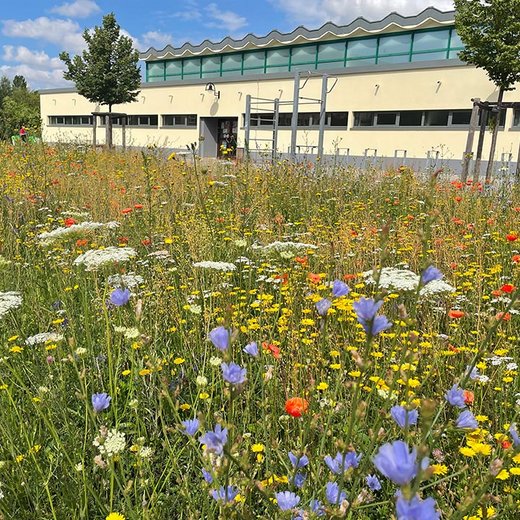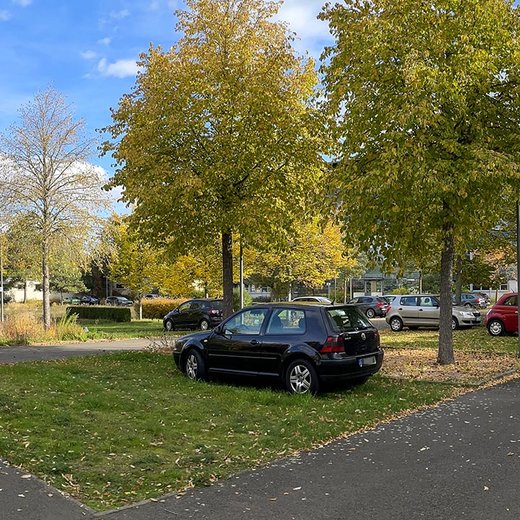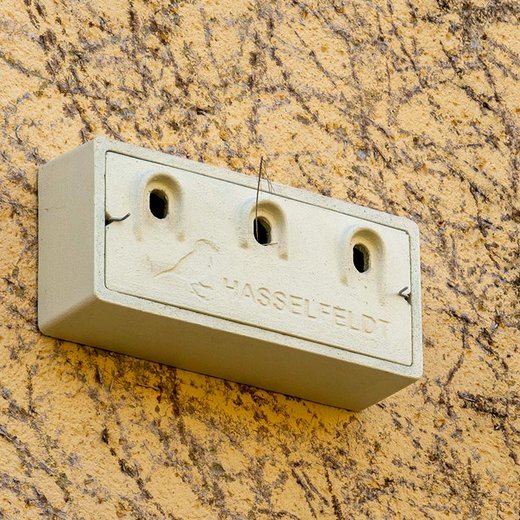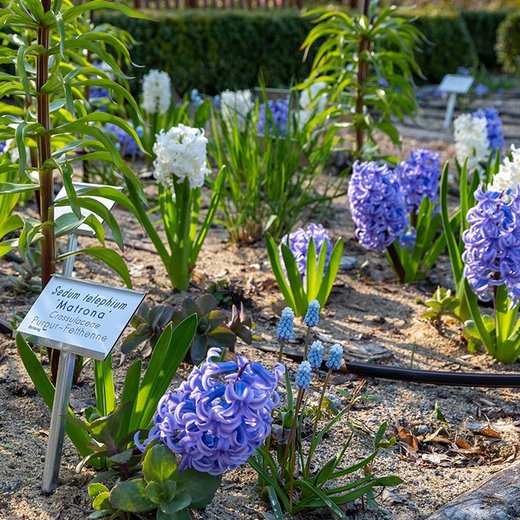A green campus encourages biodiversity and is well suited to developing and implementing targeted prevention and adaptation strategies in the wake of climate change: infiltration rate and water retention capacity are increased, roof greening measures and façade surfaces regulate the climate inside buildings, species-rich green spaces and species-protection measures such as nesting aids encourage insects and birds and, as an added bonus, raise the attractiveness of the campus as a place of work and study. Campus Bernburg in particular is setting an example.
Green Campus Projects
-
Wildflower meadows

Since 2019, seven wildflower meadows with a total area of approximately 1,100 m² have been established on Campus Bernburg and four wildflower meadows with a total area of approximately 600 m² on Campus Dessau. These actions involved the sowing of species-poor ornamental lawn areas, as well as post-construction open areas, with a species-rich mixture of area-specific wild plants adapted to the respective site. In addition, these sites will be intensively cared for and managed. As part of the redesign of outdoor facilities at Campus Köthen, a parking lot bordering the dining area, measuring approximately 150 m², will, in the fall of 2023, be sown with a species-rich mixture of native wild plants which will then be carefully maintained.
In addition to these projects, a cooperation has, since 2020, also existed between the local landlord, TAG Wohnen & Service GmbH, and Anhalt University of Applied Sciences for the purpose of redesigning the intensively mown green areas (ornamental lawns) in the Kastanienweg residential quarter, which is directly adjacent to Campus Bernburg and home to many students. After the concept of a wildflower meadow was initially tested on a small section in 2020, planning followed for the entire neighborhood. This plan has been continuously implemented since 2021. In total, nine areas covering approx. 2,400 m² have thus been sown with species-rich mixtures of native wild plants.
-
Unsealed car parks

At the Anhalt University, there are several car parks with permeable, unsealed and partially landscaped surface structures. On Campus Bernburg, for example, car parks were equipped with green pavers (at the Biotechnikum and the Innovationswerkstatt). The car parks behind the main building and at the Feldschlösschen also sport permeable surfaces. On the car parks at Hubertus on Campus Köthen, pavers with wide green gaps were used and at Building 02, pavers with wide joints were also installed. On Campus Dessau, permeable surfaces were used on the car parks at the Audimax and behind the Basedow-Haus.
-
Nesting aids for birds and insects

One focus of the field of action "Green Campus and Biodiversity" is to set up nesting aids for birds and other species on buildings, on woody plants and on green spaces on Anhalt University’s campuses. The planning and subsequent roll out of the project was conducted by members of the Sustainability Working Group (AG Nachhaltigkeit), the student initiative, “Wurzelwerk”, and the “Ornithologische Arbeitsgemeinschaft Strenzfeld” (local ornithology group) in close cooperation and coordination with both technical administrations and other employees of the three university locations.
On Campus Bernburg, the first bird nesting aids for house sparrows were installed on buildings in 2021 and have already been successfully accepted. In addition, and with support from tree maintenance experts from the regional Saxony-Anhalt Ornithologists Association, willow-reed baskets were successfully installed in treetops for long-eared owls. As part of a student project on Campus Bernburg (behind the Biotechnikum), insect shelters featuring secure deadwood elements were erected in combination with a dry wall and a wildflower meadow. The installation of bat boxes as well as nesting boxes for semi-hollow/niche nesting bird species, such as the Redstart and the Spotted Flycatcher, is currently planned for the spring of 2023 on Campus Bernburg. A nesting box for kestrels was installed at the Köthen campus in 2021. This has been equipped with a camera, which allows following the breeding activity of the kestrel pair and the goings-on inside the nest. In 2022, two more nesting boxes for building-dwelling birds were installed in the same roof.
The installation of additional nesting aids is currently in the planning and coordination phases for all three campuses.
-
Campus gardens

Contents are being developed. Please bear with us.